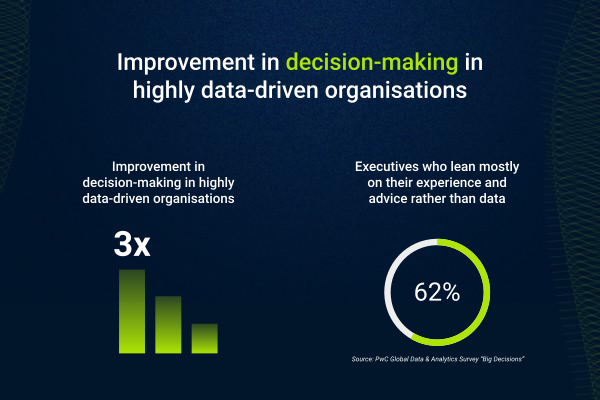Good decisions don’t just happen magically. They need to be based on the right inputs. And when you’re consistently making decisions supported by solid information, or data, your impact as a leader is bound to skyrocket.
But how do you do this? Everything boils down to understanding and becoming skilled at Data-Driven Decision-Making (DDDM).
What is Data-Driven Decision Making?
Before we dive into the intricacies of data-driven decision-making, let’s define what it is. Put simply, data-driven decision-making is the process of collecting, analysing, and interpreting data to inform and guide your decision-making. Decisions can be made based on intuition or past experiences. Or they can be made relying on a detailed understanding of data to support it.
Over the years, data-driven decision-making has evolved with the advancements in technology and the availability of vast amounts of data. Today, organisations have access to a wide array of data sources, including customer data, market trends, and operational metrics. This abundance of data presents both opportunities and challenges when it comes to making data-driven decisions.
At Data Literacy Academy, we believe that data should underpin each decision. However, we also acknowledge the need to look at the full context and use our critical thinking skills to assess whether the data is used in the right way. Internally, we prefer using the term “data-guided decisions” as this allows for the interpretation of people not just blindly following data. However, since DDDM is such a widely adopted term, we will stick to using it in this guide.
Why is Data-Driven Decision-Making important in modern business?
In today’s rapidly changing business landscape, making informed decisions can mean the difference between success and failure. Getting data is no longer the problem, knowing what to do with it is. When you work with a DDDM framework, you will benefit in the following areas.

1. Improved Accuracy
Reduce the risk of making decisions based on biased or incomplete information. By relying on objective data and analytics, you can make more accurate and reliable decisions.
2. Enhanced agility
In today’s competitive landscape, organisations need to be agile and responsive to change. DDDM allows you to quickly identify trends, detect opportunities, and respond to market dynamics more effectively.
3. Cost optimisation
Optimising resources and minimising costs should be at the top of your priority list. By analysing data, you can identify areas of inefficiency and implement strategies to drive cost savings.
4. Competitive advantage
Now you know how many executives still struggle with DDDM, you can use it to your advantage to surpass your competitors. Data-driven insights enable you to make proactive decisions that drive growth, innovation, and customer satisfaction.
5. Faster innovation
With AI and an overwhelm of tools flooding the market, leaders need to have the foundations of DDDM in place to not get left behind. DDDM will also enable your teams to make faster decisions when it comes to new product launches, enhance accurate feedback loops and help you take the right action at the right time.
What is the Process of Data-Driven Decision-Making?
Implementing data-driven decision-making requires a systematic approach. Take the time to go through each step and fairly assess where you as an individual, or the business you’re part of need work. Reaching maturity at each stage is the goal.
Before we jump into the actual process, it’s important to remember why you are going through it.
Ask yourself the core question: what strategy is this decision supporting? Data should come after your business strategy, not the other way around.
5 Key Steps Involved in the Data-Driven Decision-Making Process
1. Data collection
The first step is to collect relevant and reliable data. You will likely be looking at a variety of sources, such as internal databases, market research, or external APIs.
2. Data analysis
Once your data is collected, it needs to be analysed to extract meaningful insights. This can be done through data visualisation, statistical analysis, or using advanced analytics techniques like machine learning and predictive modelling.
3. Interpretation and insights
After the data analysis, the next step is to interpret the results and derive actionable insights. This involves understanding the implications of the data and how it aligns with your business goals.
4. Decision-making
Based on the insights derived from the data, decisions can be made with confidence. The data-driven decision-making process ensures that decisions are based on objective evidence rather than gut feelings.
5. Implementation and evaluation
Finally, decisions need to be implemented and monitored for effectiveness. Continuous evaluation and feedback help refine your future decision-making processes.
Throughout this process, it is essential to maintain data quality, ensure data governance, and adhere to ethical considerations. By following this data-driven decision-making process, your organisation can unlock the full potential of data for success.
5 Tools and Technologies for Data-Driven Decision-Making
Having the right tools and technologies in place will ensure teams can access what they need at the right time.
1. Data Management Platforms
Data management platforms help teams streamline data collection, storage, and integration processes. These platforms ensure data consistency, accuracy, and accessibility for effective data-driven decision-making. You will come across Oracle Data Management Platform, Microsoft Azure Data Services, and AWS Data Services when looking into storage solutions.
2. Cloud Computing
Cloud computing provides scalable and cost-effective infrastructure for data storage, processing, and analysis. Cloud-based platforms offer flexibility and accessibility, making data-driven decision-making more accessible to organisations of all sizes. Amazon Web Services (AWS), Microsoft Azure, and Google Cloud Platform are leaders in the cloud computing space.
3. Business Intelligence (BI) Tools
BI tools enable teams to transform raw data into meaningful insights through data visualisation, dashboards, and reports. These tools provide users with a user-friendly interface to explore and analyse data. Examples include Tableau, Power BI, and QlikView.
4. Advanced Analytics
Advanced analytics tools, such as machine learning and predictive analytics, allow you to uncover hidden patterns, predict outcomes, and optimise decision-making processes. Some well-known tools are IBM Cognos Analytics, Black Knight and Splunk.
5. Data Visualisation Tools
Data visualisation tools help in presenting complex data in a visually appealing and easily understandable format. These tools enable users to communicate data-driven insights effectively. D3.js, Tableau, and Plotly are examples of data viz tools.
6 Priorities in Data-Driven Decision Making
To successfully embrace data-driven decision-making, organisations should adhere to best practices.

1. Embrace Change Management
Communicate the benefits of data-driven decision-making and address any resistance to change. Champion data-driven initiatives and ensure buy-in from key stakeholders. Building bottom-up communities of data advocates and making sure leadership is fully on board are needed to become a data-driven company.
2. Invest in Data Quality
Ensure data accuracy, consistency, and reliability. Implement the leading data governance practices to maintain data integrity and cleanliness. Make every person understand what data is and how they are using it, even if they don’t initially think they do.
3. Foster Data Literacy
Promote a data-driven culture within your entire organisation by providing training and education on data literacy. Encourage employees to become data-savvy and use data in their decision-making processes. Make it known that data is connected to every role, not just your data team.
4. Collaborate across teams
One of the biggest challenges in large organisations is siloed operations and a lack of a single source of truth. These need to be broken down to encourage cross-functional collaboration and share insights easily.
5. Communicate insights effectively
Use data visualisation and storytelling techniques to communicate data-driven insights. Make the insights accessible and compelling to all stakeholders involved. Don’t forget to ask yourself “WHY” something is needed. Keep your audience top of mind, always.
6. Continuously monitor and evaluate
Feedback loops are easily dropped as a priority, but so essential to keep refining your decision-making processes. Set up key performance indicators to make sure everyone is working towards the same goals.
Case Studies: Success Stories in Data-Driven Decision Making
To truly understand the power of data-driven decision-making, let’s explore some real-life case studies.
These success stories demonstrate the positive impact of DDDM across various industries:
1. Healthcare
Data-driven decision-making has revolutionised healthcare by enabling personalised treatments, predicting disease outbreaks, and improving patient outcomes. Organisations like the Mayo Clinic and Johns Hopkins Institute are using data analytics to make groundbreaking medical discoveries and revolutionise patient care.
2. Finance
In the finance industry, institutions like JPMorgan Chase and Goldman Sachs, data is used to drive investment strategies, manage risks, and detect fraud. They are leaders in DDDM and a great place to seek inspiration for specific use cases.
3. Marketing
Companies like Amazon and Netflix have built their success on data-driven decision-making. By analysing customer data and preferences, they offer personalised recommendations that enhance customer satisfaction and drive massive revenue growth.
4. Retail
Big players like Asos and Shein use data to make new collections available faster to the right customers. With the help of AI to analyse millions of data points, they are reducing churn, getting faster at demand forecasting and personalising their marketing efforts more effectively than ever before. In fact, McKinsey reports that 71% of consumers now expect companies to deliver personalised interactions, and three-quarters will switch if they don’t like their experience.
The Future of Data-Driven Decision Making: Emerging Technologies and Methodologies
As technology continues to evolve, the future of data-driven decision-making holds immense potential.
1. Big Data
The growth of Big Data is providing companies with access to larger and more diverse datasets. Advanced analytics techniques are helping to unlock valuable insights from these vast amounts of data. Teams will need to stay on top of data overwhelm to make sure these floods of information help rather than harm them.
2. Internet of Things (IoT)
Since the dawn of IoT, access to real-time data from various sources is now part of the DDDM playbook. Leveraging this data enables more proactive and predictive decision-making.
3. Artificial Intelligence (AI) and Machine Learning (ML)
AI and ML technologies are rapidly automating and optimising decision-making processes. With their tremendous speed and accuracy, they can extract insights from complex data and predict far faster than any human being can manage.
4. Cloud Computing
On-premise solutions are rapidly being replaced by Cloud-based platforms. They’re making data storage scalable and flexible, enabling teams to democratise the access needed to create collaborative data-driven environments.
As these technologies and methodologies continue to evolve, businesses must stay agile and adaptable to leverage their full potential.
Top Ethical Considerations in Data-Driven Decision Making
While DDDM offers significant benefits, you can’t forget to consider the ethical implications.
1. Data Privacy
Ensure that data is collected, stored, and used in compliance with privacy regulations. Respect individuals’ privacy rights and obtain proper consent for data collection. With laws around privacy changing fast, it’s key to stay in the know of what can impact you.
2. Algorithmic Bias
How wonderful would it be if all data would be unbiased? But unfortunately, biases creep into algorithms, and as humans, we are rife with them. You can counter this by learning to understand the different biases and develop a strong skill set of critical thinking and questioning.
3. Transparency and Accountability
Be transparent about the data collection and decision-making processes. Communicate clearly how data is used and ensure accountability for the decisions made. These are both pillars for a healthy data culture and should be built into your company values to ensure you’ll be the most effective at DDDM.
By upholding these ethical standards, you’re on a sure path can build trust and maintain a positive reputation.
Conclusion
If you want to be a modern business, embracing data-driven decision-making is no longer an option but a necessity. The ability to harness the power of data will help you drive strategic outcomes, optimise costs, and provide a competitive advantage. By understanding the concept of data-driven decision-making, embracing the right tools and technologies, and adhering to best practices and ethical considerations, your organisation can unlock the full potential of data for success. So, start your data-driven journey today to make more informed decisions that will shape the future of your business.




